eISSN: 2576-4543


Review Article Voiume 9 Issue 1
Environmental Materials Theoretical Physicist, Department of Physical Mathematics Sciences Engineering Project Technologies, Engineering International Operational Teknet Earth Global, USA
Correspondence: Rajan Iyer, Environmental Materials Theoretical Physicist, Department of Physical Mathematics Sciences Engineering Project Technologies, Engineering International Operational Teknet Earth Global, Tempe, Arizona, United States of America
Received: January 06, 2025 | Published: March 5, 2025
Citation: Iyer R. Particle charge mass spin spectroscopy Ansatz physics. Phys Astron Int J. 2025;9(1):43-50. DOI: 10.15406/paij.2025.09.00362
This paper introduces a novel ansatz in fundamental particle spectroscopy physics, building upon recent advancements in signal-to-noise distributions in space-time domains. It explores particle distributions emerging from dark matter quanta and presents a conceptual framework treating time as a rank-n-tensor wavefunction, scalarized into observable quantities. Gradient gravitational interactions linking quantum gravity to M-brane theory are incorporated onto map signal/noise metrics in a manifold matrix for particle spectra. The charge-to-mass ratios (e/m) are plotted against spin quanta for fermions, bosons, and gravitons. Graphical plots derived from these mappings suggest experimental designs for testing these hypotheses at particle accelerators, such as the Large Hadron Collider (LHC), providing insights into correlations between theoretical predictions and experimental results. The study also investigates quantum gravity, dark matter, and quantum mechanics across mesoscopic to astrophysical domains, incorporating field effects that manifest as spatial-temporal path-time evolution of matter and energy, linking past, present, and future through emergent evolutionary models, supported by mathematical graphing techniques for data processing.
Keywords: Particle Spectroscopy, Quantum Gravity, Spin Spectroscopy, Dark Matter, Charge-to-Mass Ratio.
The investigation of time as a conserved quantity has long centered on its relationship with energy. However, recent advancements have proposed time1-9 as a critical player in particle dynamics and space-time conservation. Historical studies, such as those by1,10,11 revealed the behavior of space-time under extreme conditions, uncovering transitions from vacuum states to superconductive phenomena. These studies underscored the importance of signal observables in understanding the space-time continuum1,4,12,13,7-9 Furthermore, contemporary research into dark matter has speculated that particles emerging from dark matter quanta exhibit distributions influenced by both quantum and relativistic dynamics.14 This paper extends these models by conceptualizing time as a rank-n-tensor wavefunction, which can be scalarized into observable quantities in the real universe. This approach allows for the exploration of quantum gravity through geodesic interactions and links to M-brane theory.15 Additionally, the study proposes the role of symmetrical properties at both the quantum and the macroscopic scales, exploring the role of M-branes in describing the evolution of physical states in various topological configurations.
The author’s previous research includes over 55 peer-reviewed publications that span a range of topics from point physics to the Iyer-Markoulakis Helmholtz-decomposed fields, zero-point fields, and micro-blackhole tensor matrices.1,16-24 These advancements have explored how particle spectra could probabilistically emerge from superluminal condensates as well as how string metrics correlate with supersymmetric metrics, which may later be modified to account for asymmetric monopole interactions.2,12,17-19 The concept of a string metrics matrix has been extended to model fermions along the cross(para)diagonal, while bosons like Higgs boson are aligned along the diagonal, providing insight into how gravity may interact with these particles; these can be considered as the condensed form of gauged metrics fields quanta.4,12,18,20-22 Through the Hod-PDP mechanism, the study explores how vacuum solutions for energy density and quantum gravity metrics might emerge.7-9,17,18,25,26,22 The development of discontinuum physics (DCP) has further broken now through quantum and relativistic limitations, addressing inconsistencies inherent in current models.27
This author’s approach2,3,5,6 treating time as a rank-6 tensor, combines mathematically algebraic vector time and arithmetic scalar time, provided a generalized transformation using major mathematical methods such as Fourier, Laplace, Hamiltonian, Lagrange, and Legendre transforms. Through this lens, the universe is considered as a "black box," where time can be extracted as a 2x2 matrix tensor. This connects to gauge fields of light and sound, setting the stage for experimental designs that measure quantum density matrices as well as scalar metrics that characterize fundamental particles. By achieving abstract derivations of signal/noise spectra in various space-time domains, this research offers new experimental techniques to probe quantum gravity and gravitons which are hypothetical particle bosons as physics conjectures.
The spin spectroscopy physics developed in this paper, combined with reference frame logistics and time conservation principles that appear in author’s recent publications, paves the way for analyzing fermions (electron, muon, tau), bosons (photons, W and Z bosons), and gravitons. Charge-to-mass ratios (e/m) versus spin quantization are plotted to identify patterns that can guide experimental designs, helping to measure the properties of particles that underpin the four fundamental forces—electromagnetic, weak nuclear, gravitational, and strong nuclear interactions. These advancements set the stage for ongoing research to discern presence of the particles within the Standard Model while filtering out supersymmetric and antiparticle interactions. Our research also bridges quantum and astrophysical phenomena, applying group theory and 4D hyperspace studies to uncover the structure of the four fundamental forces.28-31 Astrophysical studies using Einstein-Buchdahl and Maxwell-Rindler metrics offer insights into the physical and thermodynamic properties of magnetars, black holes, and supernovae, correlating with observational data from telescopes and satellites.32
This manuscript has been configured to organize in terms of the Section 2: Methodology & Experimental Techniques to graph real particle variables, dark matter, and plot measured actual values with a new platform of Spin Spectroscopy Physics, having known charge-to-mass ratio, spin, and spectral quantum relativistic characteristics of particles, with IT tools. Section 3 graphically represents Spin Spectroscopy PHYSICS Results & Ongoing Discussions utilizing Standard Database Programming Plotting Techniques to quantitatively analyze fermions, bosons, and the gravitons with charge-to-mass e/m values versus spin number quanta, considering quantum relativistic effects due to Thomas Precession, Bohr Magneton, and Compton shift Wavelength Electromagnetic phenomena as well as gravitational graviton bosonic effects. Section 4 then elucidates further detailed specifics observed of breakthrough graphical results to real particle accelerator measurements. Summary of the results and discussions are given in the Conclusions Section 5, with References and the Appendix towards the end of this paper article manuscript.
To explore the charge-to-mass ratio, spin, and spectral characteristics of particles, the following methodologies were employed:
Ansatz signal analysis:
This analysis investigates the quantum properties of signal observables, focusing on charge, mass, and spin. It integrates relativistic dynamics, including Thomas precession, Bohr magneton effects, and Compton wavelength electromagnetism.33 The coupling of electromagnetic effects to gravitational gradients is crucial for understanding particle behavior in extreme states, such as in vacuum or superconductive environments.34 This framework allows mapping of these signals to reveal how particles behave under quantum and relativistic conditions, particularly in relation to dark matter.
Symmetry analysis:
Symmetries of particles are examined at both quantum and macroscopic scales. Quantum-level particles may exhibit five-fold symmetry, while macroscopic crystal structures are constrained to 2-fold, 3-fold, 4-fold, and 6-fold symmetries4. Experimental techniques were developed to explore supersymmetry and the effects of 4D hyperspace, particularly in virtual temporal domains. The study also considers how sense-giving fields influence path-time interactions across quantum, atomic, and astrophysical domains, with implications for understanding the expansion of the universe and the formation of astronomical objects.
M-Brane theory:
This theory, especially the concept of Planck branes, is extended to describe the evolution of physical states. Open strings (longitudinal CMBR waves) and closed strings (transverse gravitational waves) are modeled to explore how particles interact with topologically curved or curled branes.10,14,15,4,16,17,23,24 The transformation of these strings in varying environments helps explain particle dynamics on both micro and macro scales.
Artificial intelligence and programming:
AI tools and Python programming routines were applied to facilitate data access, analysis, as well as visualization. This allowed for effective processing of charge, mass, spin, and quantum properties related to dynamical effects such as Thomas precession, Bohr magneton, as well as Compton scattering.
Signal/noise distributions and particle spectra
The results suggest that particles can be modeled as real components derived from abstract imaginary fields within a matrix wavefunction. These matrices characterize interactions in dark matter, superluminal condensates, and string theory, highlighting the role of gravitational and electromagnetic forces. Gravitational closed strings and open electromagnetic strings interact in local and global loops, producing observable particle properties such as charge, mass, and spin. These interpretations were born out of the authors’ earlier thorough abstract to real mathematical physical sciences approach deriving out of first principles, as well as algorithmic graphical simulative programming algorithm.
Charge-to-mass ratios and spin quantizations
The graphical representations of signal/noise quantum matrices [ΓΨ] reveal how variations in [Ψmonopoles] generate Hermitian scalar observable points in Hilbert space. The interaction between dark matter manifolds and Ψ values leads to the creation of dipoles, consistent with Born’s rules, leading to observable phenomena, including particle spectra as governed by the Hod-PDP mechanism.12,17,20-23,25,26,35 These phenomena are visually represented in the figures:
Graphing real particles, dark matter, & e/m versus spin quanta of fermions to gravitons
Figure 1 plotting the abstract idea of "Particle =>::<= Re {abstract, i, matrix, “firewall”} versus time" with the title "Paradoxical" shows a graph that represents a dynamic relationship over time event between these variables. Since the concept is abstract and involves a quaternions mixture of symbols and notions (like matrices, complex numbers, and a firewall), it configures abstract plot to reflect these ideas, with a focus on changes over time, with the following choice of coordinates, having time on the x-axis. The concept of Re {abstract, i, matrix, “firewall”} on the y-axis, which mathematically interprets as a combination of complex and real components, mixing the elements (abstract, i, matrix, firewall) into a wave-like or fluctuating pattern over time accomplishes general graphics.
Explanation: (1) Time: The x-axis represents time varying from 0 to 10 seconds (or arbitrary units).
(2) Signal Components: (i) Real Part: A damped cosine wave representing the "abstract" component. (ii) Imaginary Part: A damped sine wave representing the "i" component. (iii) Matrix Fluctuations: Random noise symbolizes “matrix-like” fluctuations. (iv) Firewall Effect: A more complex interaction, modeled by a sine-cosine product to represent the "firewall" effects. (v) Plot: The combination of these components creates a fluctuating signal over time.
Output: The plot shows a fluctuating signal with a damping oscillation due to combination of the abstract elements, representing a paradoxical relationship over time.
Graphing Figure 2 key elements for the plot:
Explanation of the code
The plot shows the relationship between ΓΨ and [ΨFomeenko], with the middle of the plot marked by a green box that says (M) = f(Γ). The X-axis is labeled [ΨFomeenko], whereas the Y-axis is labeled “ΓΨ”.
Spin spectroscopy physics e/m vs. spin quanta plots
Particle charge, mass, spin values from googling standard database to graph (spin, e/m)
Particle Charge (C) Mass (kg) Spin (#)
Electron -1.602e-19 9.109e-31 0.5
Muon -1.602e-19 1.883e-28 0.5
Tau -1.602e-19 3.167e-27 0.5
Neutrino 0 0 0.5
Photon 0 0 1
W Boson 1.602e-19 3.183e-25 1
Z Boson 0 3.310e-25 1
Higgs Boson 0 2.225e-25 0
Graviton 0 1e-37 2
In Figures 3 (i) to 3(iv): Time-space plot depicting the activation of Hod-PDP mechanism across different energy scales bosons.
Expected output:
Assumptions:
Figure 3(1-4)
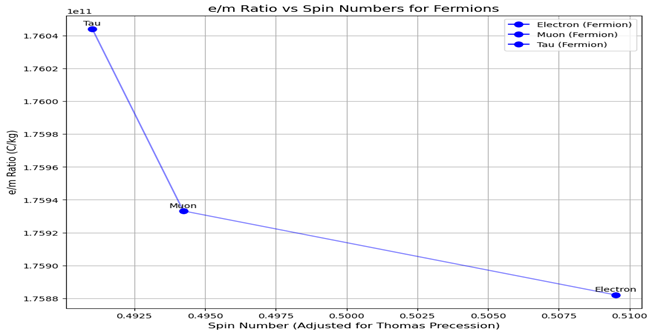
Figure 3 (i) Spin Spectroscopy Graphing PHYSICS: Charge-to-mass ratio (e/m) versus spin quanta for fermions, showing the link patterns. Visualization of the relationship between the spin and mass for particles in various quantum states.
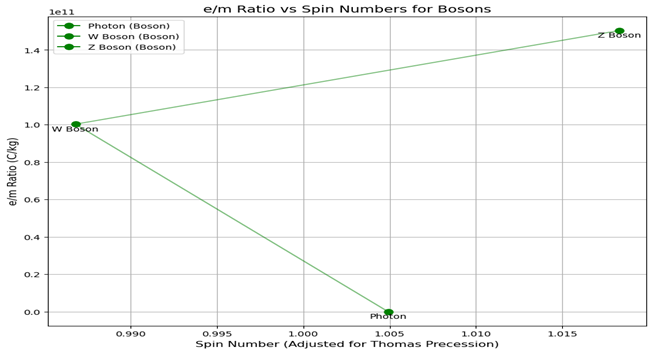
Figure 3 (ii) Spin Spectroscopy Graphing PHYSICS: Charge-to-mass ratio (e/m) versus spin quanta for bosons, showing the link patterns. Visualization of the relationship between the spin and mass for particles in various quantum states.
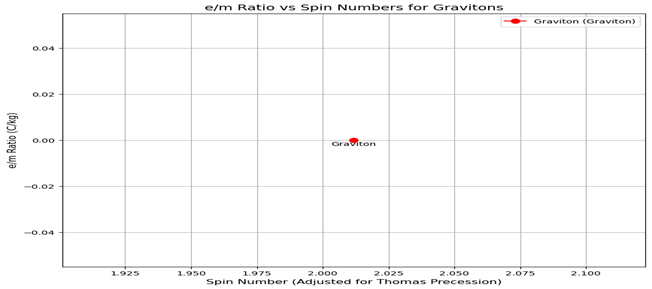
Figure 3 (iii) Spin Spectroscopy Graphing PHYSICS: Charge-to-mass ratio (e/m) versus spin quanta for gravitons, showing the link patterns. Visualization of the relationship between the spin and mass for particles in various quantum states.
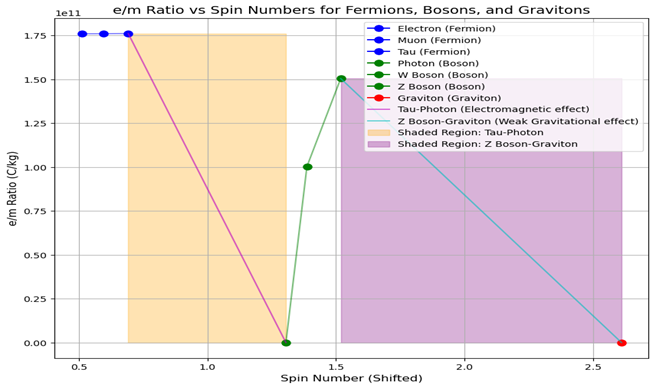
Figure 3 (iv) Comparative analysis of theoretical predictions based on Spin Spectroscopy simulations pattern of e/m charge-to-mass ratio of fermions, bosons, as well as gravitons with having quantum relativistic effects that will be hypothetically expectantly correlating with experimental data from particle accelerators futuristic predictively.
Key Changes graphing quantum relativity action Figure 4(i) to 4(iv), referring to
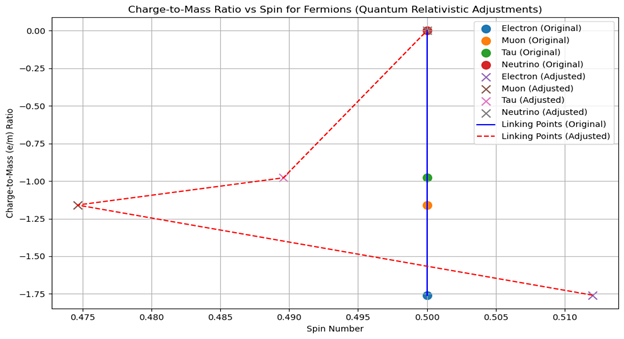
Figure 4 (i) Spin Spectroscopy Physics discerning electron, muon, and tau fermions, as well as the neutrinos with quantum relativistic adjustments, discerning differential spin charge mass particle characteristics.
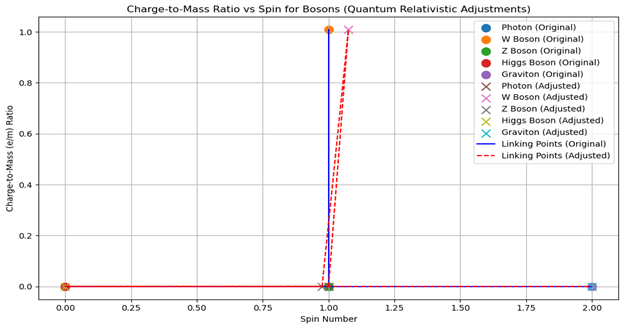
Figure 4 (ii) Spin Spectroscopy Physics discerning photons, W boson, Z boson, Higgs Bosons, gravitons with quantum relativistic adjustments, displaying differential spin charge mass particle characteristics.
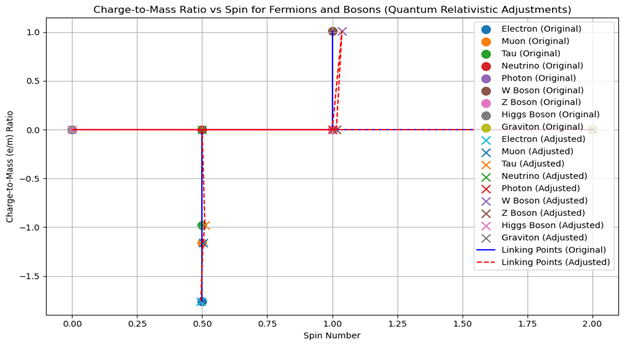
Figure 4 (iii) Spin Spectroscopy Physics discerning electron, muon, and tau fermions, as well as neutrino, Photon, W Boson, Z Boson, Higgs Boson, and the Graviton charge-to-mass e/m ratio with quantum relativistic dynamics shifting spin and e/m values as resultant of Thomas Precession, Bohr Magneton, as well as Compton electromagnetic effects.
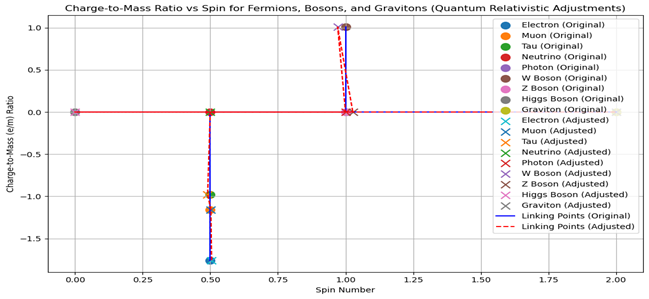
Figure 4 (iv) Spin Spectroscopy Physics discerning electron, muon, and tau fermions, as well as neutrino, Photon, W Boson, Z Boson, Higgs Boson, and the Graviton charge-to-mass e/m ratio with quantum relativistic dynamics shifting spin and e/m values as resultant of Thomas Precession, Bohr Magneton, as well as Compton electromagnetic effects. Projected conjectures would explain possibly Qquantum field interactions in mesoscopic to astrophysical regimes, helping towards electromagnetic, weak gravity, weak nuclear unification field PHYSICS.
Spin spectroscopy physics: Particle charge, mass, spin values provided above.
Figure 4(1-4)
This study contributes to the growing body of research in fundamental particle spectroscopy by introducing a novel framework that links time, quantum gravity, and M-brane theory. The analysis of charge-to-mass ratios versus spin provides valuable insights into the behavior of particles under extreme conditions. Experimental designs based on these theoretical models, particularly those involving the LHC, hold promises for verifying these hypotheses, however, based on well-known fundamental quantum measurement observational experimental values. Advancing further refinements in experimental techniques and data processing, supported by AI and programming tools, will enable more accurate measurements and deepen our understanding of the underlying forces of nature. The quantum relativistic effects considered specifically as —Thomas precession, Bohr magneton, and the Compton scattering—are shown to influence the spin and charge-to-mass ratios of particles. The findings open new possibilities for understanding dark matter, quantum gravity, and the fundamental forces across scales, from quantum to astrophysical domains. Advanced future research will focus on refining these models and comparing them with experimental data.
This study introduces a novel ansatz for particle spectroscopy, combining quantum gravity as well as M-brane theory to explore particle behavior through signal/noise distributions. These ansatz findings suggest new directions for experimental designs, particularly at particle accelerators such as the LHC. The charge-to-mass ratio and spin quantization are found to be key markers in understanding fundamental particle interactions. Theoretical models predict correlations between spin, charge-to-mass ratios, and quantum relativistic effects, providing a framework for experimental verification. Specifically, charge and spin affected by Thomas Precession, Bohr Magneton, as well as Compton electromagnetic effects, with fermions, bosons, and the gravitons linked by electromagnetic-gravitational interactions were highlighted by graphs. Symmetry analysis having Special Unitary Group spatial and temporal structures were projected to manifest within the novel ansatz Spin Spectroscopy particle PHYSICS. Future research will continue to refine these models and align them with experimental results, advancing our understanding of the fundamental forces governing the universe.
Engineering Inc. International Operational Teknet Earth Global has provided a platform launching wonderful ongoing projects that will be most useful to future human progress. Scientists worldwide specifically have contributed to the success of RESEARCHGATE forums as well as Virtual Google Meetings posted on YouTube as well per TEKNET EARTH GLOBAL SYMPOSIA (TEGS) website: https://www.youtube.com/channel/UCdUnenH0oEFiSxivgVqLYw that has successfully promoted peer-reviewed publications with ongoing project work. It is with great honor and gratitude that the author would be liking to thank collaborative international physicists ‘scientists starting with Dr. Emmanouil Markoulakis, Experimental Physicist with Hellenic Mediterranean University, Greece in mutually coauthored peer publications of many ansatzes breakthrough sciences to explore and successfully pursue quantum astrophysics. The author would too like to thank and be always grateful to Mr. Christopher O’Neill, IT Physicist with Cataphysics Group, Ireland for peer coauthored papers publications, professional graphics, and expert comments with collaborative evaluator feedback on the key contents, especially with TEKNET conference sessions discussing concepts and the graphics suggestions appreciatively exceptionally mutual project workouts ongoing. With highly engaging fruitful debates as well as discussions, the author extends profoundly high appreciation to project collaboratively engaging physicists Drs. Manuel Malaver, John Hodge, Emory Taylor, Wenzhong Zhang, Andreas Gimsa, Christian Wolf, Gerd Pommerenke, and other participating scientists. The author would be always indebted to many upcoming progressive outstanding journals who have promoted publications with excellent peer reviews of our papers’ articles.
The author received no financial support for the research, authorship, and/or publication of this article.
The authors do not have any conflict of interest.
The sole author was responsible for the conceptualization, methodology, data collection, analysis, writing, and final approval of the manuscript.
Spin Spectroscopy Physics discerns electron, muon, and tau fermions, and neutrino charge-to-mass (e/m) ratio with quantum relativistic dynamics shifting spin and e/m values as resultant of Thomas Precession, Bohr Magneton, and Compton electromagnetic effects.
Jupyter code program input output workout:
import numpy as np
import matplotlib.pyplot as plt
# Define the fermion and boson particles and their properties
particles = {
# Fermions
'Electron': {'spin': 1/2, 'charge_to_mass': -1.758820, 'correction_factor': 0.01, 'charge': -1.602e-19, 'mass': 9.109e-31},
'Muon': {'spin': 1/2, 'charge_to_mass': -1.1595, 'correction_factor': 0.02, 'charge': -1.602e-19, 'mass': 1.883e-28},
'Tau': {'spin': 1/2, 'charge_to_mass': -0.9785, 'correction_factor': 0.03, 'charge': -1.602e-19, 'mass': 3.167e-27},
'Neutrino': {'spin': 1/2, 'charge_to_mass': 0, 'correction_factor': 0, 'charge': 0, 'mass': 0}, # Neutrino has negligible charge-to-mass ratio
# Bosons
'Photon': {'spin': 1, 'charge_to_mass': 0, 'correction_factor': 0, 'charge': 0, 'mass': 0}, # Photon has no charge and zero mass
'W Boson': {'spin': 1, 'charge_to_mass': 1.008, 'correction_factor': 0.05, 'charge': 1.602e-19, 'mass': 3.183e-25},
'Z Boson': {'spin': 1, 'charge_to_mass': 0, 'correction_factor': 0.05, 'charge': 0, 'mass': 3.310e-25},
'Higgs Boson': {'spin': 0, 'charge_to_mass': 0, 'correction_factor': 0, 'charge': 0, 'mass': 2.225e-25}, # Higgs has no charge
'Graviton': {'spin': 2, 'charge_to_mass': 0, 'correction_factor': 0, 'charge': 0, 'mass': 1e-37}, # Graviton has no charge and negligible mass}
# Apply quantum relativistic corrections (Bohr magneton, Thomas precession, etc.)
for particle, data in particles.items():
# Adjusting the spin slightly due to quantum relativistic effects (Thomas precession)
data['adjusted_spin'] = data['spin'] + np.random.normal(0, data['correction_factor'])
# Generate the plot
fig, ax = plt.subplots(figsize=(10, 6))
# Plot the original particles with charge-to-mass ratio (e/m) vs spin number
for particle, data in particles.items():
ax.scatter(data['spin'], data['charge_to_mass'], label=f'{particle} (Original)', s=100, marker='o')
# Plot the adjusted spins after quantum relativistic corrections
for particle, data in particles.items():
ax.scatter(data['adjusted_spin'], data['charge_to_mass'], label=f'{particle} (Adjusted)', s=100, marker='x')
# Link the points for original and adjusted scales
particle_spins_original = [data['spin'] for data in particles.values()]
particle_charge_to_mass = [data['charge_to_mass'] for data in particles.values()]
ax.plot(particle_spins_original, particle_charge_to_mass, 'b-', label='Linking Points (Original)')
# Link the points for the adjusted scale
particle_spins_adjusted = [data['adjusted_spin'] for data in particles.values()]
ax.plot(particle_spins_adjusted, particle_charge_to_mass, 'r--', label='Linking Points (Adjusted)')
# Labels and grid
ax.set_xlabel('Spin Number')
ax.set_ylabel('Charge-to-Mass (e/m) Ratio')
ax.set_title('Charge-to-Mass Ratio vs Spin for Fermions, Bosons, and Gravitons (Quantum Relativistic Adjustments)')
ax.grid(True, which='both')
# Add legend
ax.legend()
# Show plot
plt.tight_layout()
plt.show()
# Output particle properties
print(f"{'Particle':<15} {'Charge (C)':<20} {'Mass (kg)':<20} {'Spin':<10} {'Charge-to-Mass (e/m)':<25}")
for particle, data in particles.items():
print(f"{particle:<15} {data['charge']:<20} {data['mass']:<20} {data['spin']:<10} {data['charge_to_mass']:<25}")
Per {Figure 4 (iv): Quantum field interactions in mesoscopic to astrophysical regimes. Electromagnetic, weak gravity, weak nuclear unification field PHYSICS.}
Hyper Unification PHYSICS gage field theoretical modeling simulations
Figure 1: Signal pattern Re {abstract, i, matrix, “firewall”} as a function of time coordinates.
Figure 2: Mapping of Signal/noise spectra in the context of dark matter manifolds quanta
Figure 3 (i): Spin Spectroscopy Graphing PHYSICS: Charge-to-mass ratio (e/m) versus spin quanta for fermions, showing the link patterns. Visualization of the relationship between the spin and mass for particles in various quantum states.
Figure 3 (ii): Spin Spectroscopy Graphing PHYSICS: Charge-to-mass ratio (e/m) versus spin quanta for bosons, showing the link patterns. Visualization of the relationship between the spin and mass for particles in various quantum states.
Figure 3 (iii): Spin Spectroscopy Graphing PHYSICS: Charge-to-mass ratio (e/m) versus spin quanta for gravitons, showing the link patterns. Visualization of the relationship between the spin and mass for particles in various quantum states.
Figure 3 (iv): Comparative analysis of theoretical predictions based on Spin Spectroscopy simulations pattern of e/m charge-to-mass ratio of fermions, bosons, as well as gravitons with having quantum relativistic effects that will be hypothetically expectantly correlating with experimental data from particle accelerators futuristic predictively.
Figure 4 (i): Spin Spectroscopy Physics discerning electron, muon, and tau fermions, as well as the neutrinos with quantum relativistic adjustments, discerning differential spin charge mass particle characteristics.
Figure 4 (ii): Spin Spectroscopy Physics discerning photons, W boson, Z boson, Higgs Bosons, gravitons with quantum relativistic adjustments, displaying differential spin charge mass particle characteristics.
Figure 4 (iii): Spin Spectroscopy Physics discerning electron, muon, and tau fermions, as well as neutrino, Photon, W Boson, Z Boson, Higgs Boson, and the Graviton charge-to-mass e/m ratio with quantum relativistic dynamics shifting spin and e/m values as resultant of Thomas Precession, Bohr Magneton, as well as Compton electromagnetic effects.
Figure 4 (iv): Spin Spectroscopy Physics discerning electron, muon, and tau fermions, as well as neutrino, Photon, W Boson, Z Boson, Higgs Boson, and the Graviton charge-to-mass e/m ratio with quantum relativistic dynamics shifting spin and e/m values as resultant of Thomas Precession, Bohr Magneton, as well as Compton electromagnetic effects. Projected conjectures would explain possibly Qquantum field interactions in mesoscopic to astrophysical regimes, helping towards electromagnetic, weak gravity, weak nuclear unification field PHYSICS.
Applying derivations mathematical physical sciences, the author has advanced over the years now,1-9,12,13,16-24 it is possible to transition from mathematical physics, theoretical physics onto particle astrophysics, with experimental physics showing proof of the concept, especially SPIN SPECTROSCOPY PHYSICS graphing programmable algorithm derived here.
These findings suggest that mathematical models can describe the activation of particles and their subsequent behavior, linking them to known parameters of charge, mass, and spin. As particles are mapped from abstract fields to real components in space-time, these results offer novel insights into dark matter, quantum gravity, and the mechanisms governing particle formation in the universe.

©2025 Iyer. This is an open access article distributed under the terms of the, which permits unrestricted use, distribution, and build upon your work non-commercially.